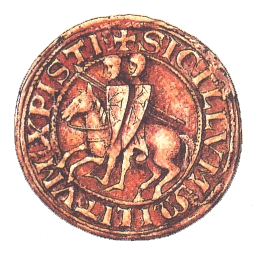
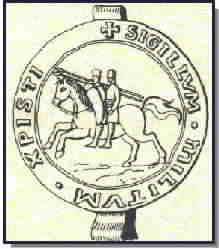
The Image at the left is a copyright of Templar Books. Permission to use it has been granted by our friend and brother Knight, Stephen Dafoe. The seal to the right is a link to Wikipedia.


If You Enjoy Music |
Music from 'Titanic'
Since this page is accessable from most search engines we will inform you that; There are NO Templar or Freemasonic secrets here, such as signs, handshakes, or secret words. These are only available as members of the order to which they apply. What we cover here is available to anyone who 'seeks the truth'...However this information is strictly from a personal research point of view and not all Knights Templar members or Freemasons agree with it. The comments of those who agree are to be found in our guestbook and those Masonic sites or webmasters who concur are mentioned on our pages.
On this page we will explore some of the history of the Knights and we will cover the much more controversial aspect of the Merovingians, who may be blood-line descendents of Jesus and his family. We also include the Rennes le Chateau mystery which seems to be the talk of everybody these days and the much debated story of a certain M. Plantard who claimed descent from Jesus. Much of this research is provided by the books Holy Blood Holy Grail by Lincoln, Baigent and Leigh and the Magdalene Legacy by Laurence Gardner.
There is also a huge and very informative site built and maintained by Stephen Dafoe @ magicworks, link below, however his site does not include anything about the Essenes or other "Ancient" connections that may have began before actual Templar recorded history. He has promised to include these in the future. We will try to cover as many aspects of the story as possible here.
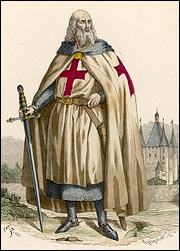 News: October 12, 2007; Knights cleared of hearsy charges by Pope Clement!! The document,
known as the Chinon parchment,
reveals that the Templars had been charged with having an initiation ceremony which
involved "spitting on the cross", "denying Jesus" and kissing the lower back, navel and mouth
of the man proposing them. The document apparently cleared them of these charges 700 years ago.
News: October 12, 2007; Knights cleared of hearsy charges by Pope Clement!! The document,
known as the Chinon parchment,
reveals that the Templars had been charged with having an initiation ceremony which
involved "spitting on the cross", "denying Jesus" and kissing the lower back, navel and mouth
of the man proposing them. The document apparently cleared them of these charges 700 years ago.
In 2002, Dr. Barbara Frale found a copy of the Chinon Parchment in the Vatican Secret Archives, a document which indicated that Pope Clement V absolved the leaders of the Order in 1308. She published her findings in the Journal of Medieval History in 2004 .
Before the inquisitions, The Templars explained to Pope Clement that the initiation mimicked the humiliation that knights could suffer if they fell into the hands of the Saracens, while the kissing ceremony was a sign of their total obedience.
The Pope concluded that the entrance ritual was not truly blasphemous, as alleged by King Philip when he had the knights arrested. However, he was forced to dissolve the Order to keep peace with France and prevent a schism in the church.
A new book, Processus contra Templarios, was published by the Vatican's Secret Archive on Oct 25, 2008 and promised to restore the reputation of the Templars, whose leaders were burned as heretics when the order was dissolved in 1314. Our question is; Why are they revealing this now?...And what else are they hiding?
What really Happened
The final fall of the Templars may have started over the matter of a loan. The young Philip IV, King of France (also known as "Philip the Fair") had needed cash for his war with the English and asked the Templars for more money. They refused. The King assigned himself the right to tax the French clergy, and he tried to get the Pope to excommunicate the Templars, but Pope Boniface VIII refused, instead issuing a Papal Bull in 1302 to reinforce that the Pope had absolute supremacy over earthly power, even above a king, and excommunicated King Philip instead. The king responded by sending his councillor, Guillaume de Nogaret, in a plot to kidnap the Pope from his castle in Anagni in September 1303, charging him with dozens of trumped-up charges such as sodomy and heresy. see History of the Knights Templar
"This is proof that the Templars were not heretics," said Prof Frale. "The Pope, Bertrand de Goth (Clement V), a childhood friend of Philip, was obliged to ask pardon for the knights in June 1305. Clement withdrew the Papal Bulls of Boniface VIII which had conflicted with Philip IV's plans, created nine more French cardinals, and, after a failed attempt to unite the Templars and the Hospitallers, agreed to Philip IV's demands for an investigation of the Templars. Pope Clement also moved the papacy from the Italian Anagni to the more palatable (and controllable) French Avignon, initiating the period called the Avignon Papacy.
"For 700 years we have believed that the Templars died as cursed men, and this absolves them." story.. Vatican secret papers
 The Knights Templar, Henry Sinclair in particular, discovered America in 1398. They sailed to
find the place marked by a star on a map called la Merica. This star and the mythical land
below it were known to have originated from scrolls found beneath Herod's Temple. When the Templars
had been 'outlawed' in Europe, they undertook this search for the perfect land
that lay over the great sea to the west. The 'la Merica' star is the reason the USA is called America.
They landed on the coast of Nova Scotia, Canada in 1398. see
Intro 5
The Knights Templar, Henry Sinclair in particular, discovered America in 1398. They sailed to
find the place marked by a star on a map called la Merica. This star and the mythical land
below it were known to have originated from scrolls found beneath Herod's Temple. When the Templars
had been 'outlawed' in Europe, they undertook this search for the perfect land
that lay over the great sea to the west. The 'la Merica' star is the reason the USA is called America.
They landed on the coast of Nova Scotia, Canada in 1398. see
Intro 5
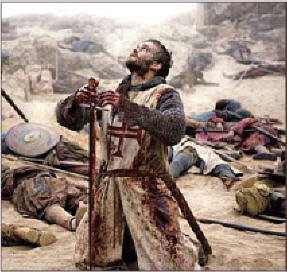 The trial of the Templars between 1307 and 1312 was marked by a battle of political wills
between King Philip IV on the one hand and Pope Clement V on the other. After the French
Templars had been taken into royal custody in October 1307, Clement quickly realised that he
could have no influence on the outcome until he could gain access to the Templars themselves,
especially the leaders. In June 1308, at Poitiers, after a long struggle, he finally achieved his goal,
hearing the confessions of 72 selected Templars, whom he then absolved. However, the king
still retained the leaders, holding them at Chinon castle rather than allowing them to appear
before the papal Curia. Eventually, in late August 1308, a papal commission did hear the
leaders, although until now the evidence for this was indirect, contained in a letter preserved
in the French Chancery. The recent discovery of the papal documents containing the record
of these hearings, which culminated in the absolution of the leaders, places them in a
completely new light and suggests that the views of Clement V and other principals in
the trial need to be radically reappraised.
The trial of the Templars between 1307 and 1312 was marked by a battle of political wills
between King Philip IV on the one hand and Pope Clement V on the other. After the French
Templars had been taken into royal custody in October 1307, Clement quickly realised that he
could have no influence on the outcome until he could gain access to the Templars themselves,
especially the leaders. In June 1308, at Poitiers, after a long struggle, he finally achieved his goal,
hearing the confessions of 72 selected Templars, whom he then absolved. However, the king
still retained the leaders, holding them at Chinon castle rather than allowing them to appear
before the papal Curia. Eventually, in late August 1308, a papal commission did hear the
leaders, although until now the evidence for this was indirect, contained in a letter preserved
in the French Chancery. The recent discovery of the papal documents containing the record
of these hearings, which culminated in the absolution of the leaders, places them in a
completely new light and suggests that the views of Clement V and other principals in
the trial need to be radically reappraised. from Journal of Medieval History
The legends claim that the Templars survived by settling in Scotland and Switzerland under the guise of a secret society, “The Brotherhood.” The Rosicrucians in their Fama Fraternitatis—History of the Brotherhood—published in 1614, and other esoteric groups since then, have claimed a direct connection.
Some historians neglected to mention the crucial link between the French King and his puppet pope, Clement V. Only a handful mentioned the Templars’ mystical practice, and most assumed that they were strictly Catholic. The majority paid little attention to their tactics, military hierarchy, the weapons and armor used, and ignored the training necessary to create a highly skilled and disciplined army.
Few people know that the Brotherhood’s reason for being was to safeguard their Gnostic practice, as was the case with other groups. After reading up on Gnosticism, things made sense, such as the Templars’ flag—black and white—called Beauseant, “To Be Whole,” also their battle cry. Spiritual wholeness was a goal in Gnosticism, a mystical path of Jesus and his disciples according to the recently translated ancient documents, in the Nag Hammadi Library. But this was an original version—centered on meditation, what Jesus taught and the Templars inherited and found in present-day Kabbalah, Sufism, and Mystical Christianity—rather than the sect of dogma and ritual that evolved over the centuries.
The Templars’ apparent destruction was just one more chapter in a covert war that started in 1294, three years after they left the Holy Land. It was Lord Otto de Grandson who learned early on of the French King’s plans for empire and maneuvered the Brotherhood to fight him, using a mystical treasure portrayed both as the Ark of the Covenant and the Holy Grail—the means to talk directly to God, and a physical link to Jesus—and we surmised that it had to have been a Gnostic manuscript written by Jesus. We now have no doubt that such a document existed, that it was the ”treasure” mentioned in the legends, and that it was the catalyst for the Templars’ survival.
Is There Connection between the Freemasons and the Templars?
Dr. W. Wynn Westcott, in transactions of Quatuor Coconati in 1915 says that the truth appears to be that the Essenes, the school of Pythagoras, and the freemasons derive their similarity from the spirit of brotherhood which has prevailed in all ages of the civilized world. The inherent principles of which, as the results of any fraternity-all members of which are engaged in the same pursuit and assenting to the same secrecy which gives them their exclusiveness, and hence, between all fraternities, ancient and modern, these remarkable coincidences are found.
The Essenes, who practiced from 2BC to 2AD have been rediscovered in the writing of the Dead Sea Scrolls. They had three degrees, Aspirant, Associate and Companion. Philo, Pictet and Basnage are quoted as saying; "When a candidate was proposed for admission, the strictest scruting was made of his character. If his life had hither been exemplary, and if he appeared capable of curbing his passions and regulating his conduct, according to the virtuous, through austere maxims of their order, he was presented, at the expiration of his novitiate with a white garment, as an emblem of the regularity of his conduct and the purity of his heart. A solemn oath was then administered to him, that he would never divulge the mysteries of the order; that he would make no innovations of the doctrines of the society; and that he would continue in that honorable course of piety and virtue which he had begun to persue. Like freemasons they instructed the young members in the knowledge which they derived from their ancestors.
They admitted no women into their order.. They had particular signs for recognizing each other , which have a strong resemblance to these of freemasons. They had colleges or places of retirement, where they resorted to practice their rites and settle the affairs of the society; and after the performance of these duties, they assembled in a large hall where entertainment was provided for them by the president, or master of the college, who alloted a certain quanity of provisions to every individual. They abolished all distinctions of rank; and if preference was ever given, it was given to piety, liberality, and virtue. Treasurer's were appointed in every town to supply the wants of indigent strangers".
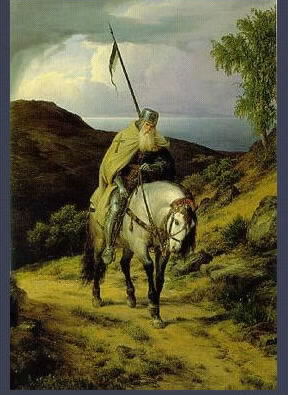
The origional Knights called 'Soldiers of the Temple' and the 'Order of the Temple (Knights Templar) and Sion' and were apparently unified under one leadership. Apparently they split up after an incident called 'the cutting of the elm' in 1188 for reasons we will get into shortly . In 1307, Guillaume de Gisors, the Grand Master of the Ordre of Sion at the time, received what is described as the 'golden head' with a label, Caput LVIII, from the Order of the Temple. In the Dossier documents, (The Divinci Code, Holy Blood Holy Grail and several others ) there is evidence that some how this de Gisors helped King Phillippe perpetuate the attact on the Templars. He was listed as being a colleague of Guillaume Pidoye, one of King Philippe's men. But at the same time he may have warned the Templars that Philippe was going to arrest them, allowing most of them to escape. Page 126-pb Holy Blood Holy Grail
The Dossier secret documents;
Because of all the buzz about the book The Da Vinci code, we think more explaination is needed to support the book Holy Blood Holy Grail and it's authors and the susposed hoax of Pierre Plantard, Gerald de Sede and the list of descendents of the Merovingians - Merovingians being those families who allegedly descended from Mary Magdalene and Jesus and his immediate family. The family tree derived from the Dossier documents which goes back to King David, is on the next page. But there is more than one of these. One is held in the Demarest Museum in Demarest, New Jersey, USA. It is completely independent of the other two. Thats right 2. A presentation scroll called the scroll of Jasher also lists the bloodline descendents. This list is also displayed in Laurence Gardner's books, Bloodline of the Holy Grail and in The Magdalene Legacy
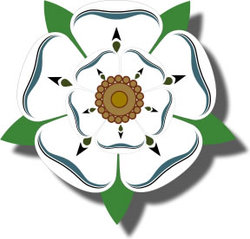 Sir Laurence Gardner, whom we reference many times here, is
Kt St Gm, KCD, is an internationally known sovereign and chivalric genealogist. He holds the
position of Grand Prior of the Celtic Church's Sacred Kindred of Saint Columba, and is
distinguished as the Chevalier Labhràn de Saint Germain. Sir Laurence is also Presidential
Attaché to the European Council of Princes, a constitutional advisory body established in
1946. He is formally attached to the Noble Household Guard of the Royal House of
Stewart, founded at St Germain-en-Laye in 1692, and is the Jacobite Historiographer
Royal. If you have done any research at all, you know that the 'House of Stewart' and the
Jacobites are very important to
the history of the order.
Sir Laurence Gardner, whom we reference many times here, is
Kt St Gm, KCD, is an internationally known sovereign and chivalric genealogist. He holds the
position of Grand Prior of the Celtic Church's Sacred Kindred of Saint Columba, and is
distinguished as the Chevalier Labhràn de Saint Germain. Sir Laurence is also Presidential
Attaché to the European Council of Princes, a constitutional advisory body established in
1946. He is formally attached to the Noble Household Guard of the Royal House of
Stewart, founded at St Germain-en-Laye in 1692, and is the Jacobite Historiographer
Royal. If you have done any research at all, you know that the 'House of Stewart' and the
Jacobites are very important to
the history of the order.
Laurence Gardner has been granted privileged access to European Sovereign and Noble archives, along with favored insight into Chivalric and Church repositories. He proves for the first time that there is a royal heritage of the Messiah, and documents the systematic and continuing suppression of these records tracing the descent of the sacred lineage down through the centuries.
The Merovingians were know about in the time of Pope Gregory (540-604), who we indentified as the instigator of the 'Mary Magdalene the Prostitute' myth on our 'Forbidden series'.. For those of you who haven't read the books, we will recap briefly the important points and facts that Lincoln, Baigent and Leigh found to support the claims in the documents. Holy Blood Holy Grail took 12 years of research and it has everything to do with The Knights Templar. Many Templar orders in the UK are now called 'Priory'. Links to those and other sites are on the bottom of the page.
We leave it up to the reader to determine if the Priory is fake or not or what it's purpose was or is. We have however found evidence that the Merovingian family is real and continues. We get into this on the next page. If you are not interested in this go to .. Page #3 - The Crusades and more. Another link... Rennes-le-Chateau Links
The Priory de Sion
Information from the pages of Holy Blood Holy Grail: First we must mention that three people
were found dead in Paris after the publication of a book called Le Serpent rouge.
The poem Le Serpent Rouge consists of thirteen stanzas, each dedicated to one of the
thirteen houses of the Priory of Sion‘s zodiac system. The authors are purported to be
Louis Saint-Maxent, Pierre Feugere, and Gaston de Koker, who were all killed shortly after
the poem was published. Strange and frightening as this may seem, these men may
not have in fact been the authors, for the poem does not appear to be the work of
a committee, but rather a single quixotic mystic. My theory is that the true author
of the poem was Jean Cocteau. One only needs to read Cocteau’s known work, or
view his film Orpheus, to recognize the style of writing and the symbolism employed.
Also, it was published just a few years after his death, and it was during Cocteau’s
grand mastership that the publication of “Priory documents” such as this one began.
see tracyrtwymanTracy rt Wyman
The man we (Lincoln, Baigent & Leigh) identified as Comte Henry de Lenoncount, (pb p 100) was a French aristocrat of distinguished lineage, who had been living under an assumed name. He was known as Leo Schidlof. He was living in Vienna until his death in 1966. This place and date was in the Dossiers secrets. Shortly after Schidlof's death a briefcase was to have passed into the hands of a courier. The courier was Fakhar ul Islam. He was carring secret documents relating to Rennes-le-Chateau between 1600 and 1800. He was to rendezvous with an 'agent delegated by Geneva' in East Germany on Feb. 20, 1967. Fakhar had been expelled from Germany and was 'to wait in Paris for further orders.' On that day his decapitated body was found on the railroad tracks at Melun, after having been hurled from the train. The briefcase had vanished. The incident was investigated by The Directory of Territorial Surveilance, or Counterespionage. pages 100-103 Holy Blood Holy Grail. Keep in mind that the documents contained information that would have affected the church and it's dogmatic doctrines.
The formation of the Ordre de Sion
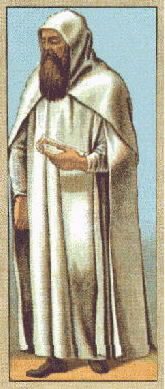 A work in the 1930's by Rene Grousset, contains a quotation that refers to Baudouin (Baldwin)
I, younger brother of Godfroi de Bouillon, duke of Lorraine and conqueror of the Holy Land.
On Godfroi's death Baudouin accepted the crown offered to him and thereby became the first
official king of Jerusalem. According to Rene Grousset there existed, through Baudouin I,
"a royal tradition". And because it was "founded on the rock of Sion," this tradition was
"equal" to the reigning dynasties in Europe. On the page in the Dossier secrets Grousset's
quotation is followed by an allusion to the mysterious Prieure de Sion - or Ordre de Sion
as it was apparently called at the time. According to the text the Ordre of Sion was founded
by Godfroi de Bouillon in 1090, nine years before the conquest of Jerusalem.
A work in the 1930's by Rene Grousset, contains a quotation that refers to Baudouin (Baldwin)
I, younger brother of Godfroi de Bouillon, duke of Lorraine and conqueror of the Holy Land.
On Godfroi's death Baudouin accepted the crown offered to him and thereby became the first
official king of Jerusalem. According to Rene Grousset there existed, through Baudouin I,
"a royal tradition". And because it was "founded on the rock of Sion," this tradition was
"equal" to the reigning dynasties in Europe. On the page in the Dossier secrets Grousset's
quotation is followed by an allusion to the mysterious Prieure de Sion - or Ordre de Sion
as it was apparently called at the time. According to the text the Ordre of Sion was founded
by Godfroi de Bouillon in 1090, nine years before the conquest of Jerusalem.
Bouillon built an abbey on the ruins of a Byzantine basilica. It was named Notre Dame de Sion and knights were attached to the abbey. According to one chronicler, writing in 1172, it was extremely well fortified, with its own walls, towers and battlements. Another historian writing in 1698, is more explicit still: "There were in Jerusalem during the Crusades...Knights attached to the Abbey of Notre Dame de Sion who took the name of Chevaliers de l'Ordre de Notre Dame de Sion."
It is known that in 1070, twenty-nine years before the First Crusade, a specific band
of monks from Calabria in southern Italy arrived in the vicinity of the Ardennes Forest,
part of Godfroi de Bouillon’s domains. According to Gerard de Sade this band of monks
was led by an individual called Ursus - a name the “Prieure documents” consistently
associates with the Merovingian bloodline. On their arrival in the Ardennes the Calabrian
monks obtained the patronage of Mathilde de Toscan, duchess of Lorraine - who was Godfroi
de Bouillon’s aunt and, in effect, foster mother. From Mathilde the monks received a
tract of land at Orval, far from Stenay, where Dagobert II had been assassinated some
five hundred years earlier. Here an abbey was established to house them. Nevertheless,
they did not remain at Orval very long. By 1108 they had mysteriously disappeared,
and no record of their whereabouts survives. Tradition says they returned to Calabria.
Orval, by 1131, had become one of the fiefs owned by Saint Bernard.
Lincoln, Baigent, Leigh - Holy Blood Holy Grail
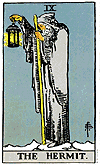 This is a card in the Tarot Deck. See the Secret meanings the cards contain on our special page,
Knights Tarot.
Peter the Hermit is often believed to have been Godfroi de Bouillon’s personal tutor.
Nor is that his only claim to fame. In 1095, along with Pope Urban II, Peter made himself known
through out Christendom by charismatically preaching the need for a crusade-a holy war that would
reclaim Christ’s sepulchre and the Holy Land from the hands of the Muslim infidel. Today Peter the
Hermit is regarded as one of the chief instigators of the Crusades.
This is a card in the Tarot Deck. See the Secret meanings the cards contain on our special page,
Knights Tarot.
Peter the Hermit is often believed to have been Godfroi de Bouillon’s personal tutor.
Nor is that his only claim to fame. In 1095, along with Pope Urban II, Peter made himself known
through out Christendom by charismatically preaching the need for a crusade-a holy war that would
reclaim Christ’s sepulchre and the Holy Land from the hands of the Muslim infidel. Today Peter the
Hermit is regarded as one of the chief instigators of the Crusades.
On the basis of hints intimated in the “Prieuré documents” we (L,B,L) began to wonder whether there might have been some sort of shadowy continuity between the monks of Orval, Peter the Hermit, and the Ordre de Sion. It would certainly seem that the monks at Orval were not just a random band of itinerant religious devotees. On the contrary their movements - their collective arrival in the Ardennes from Calabria and their mysterious disappearance en masse - attest to some kind of cohesion, some kind of organization, and perhaps a permanent base somewhere. And if Peter were a member of this band of monks, his preaching of a crusade might have been a manifestation, not of rampant fanaticism, but of calculated policy. If he was Godfroi’s personal tutor, moreover, he might well have played some role in convincing his pupil to embark for the Holy Land. And when the monks vanished from Orval, they might not have returned to Calabria after all. They might have established themselves in Jerusalem, perhaps in the Abbey of Notre Dame de Sion.
This, of course, was only a speculative hypothesis, with no documentary confirmation. Again, however, we soon found fragments of circumstantial evidence to support it. When Godfroi de Bouillon embarked for the Holy Land, he is known to have been accompanied by an entourage of anonymous figures who acted as advisers and administrators-the equivalent, in effect, of a modem general staff. Alone among the European commanders, he renounced his fiefs, sold all his goods, and made it apparent that the Holy Land, for the duration of his life, would be his domain.
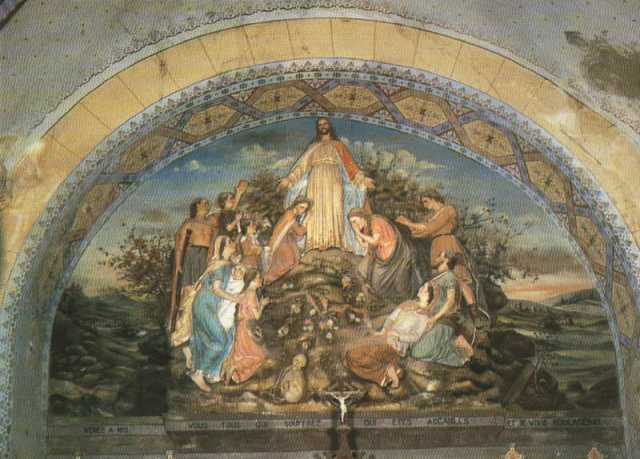 In 1099, just after the capture of Jerusalem,
a group of anonymous figures convened in
secret conclave. The identity of this group has eluded all historical inquiry - although
Guillaume de Trye, writing three quarters of a century later, reports that the most important
of them was a 'certain bishop of Calabria.' If this bishop was Saint Bernard, his uncle
was Andre de Montbard.
Montbard and Bernard have been confirmed as being members of the Ordre de Sion. In
1104 the count of Champagne had met in conclave with certain high-ranking nobles, at
least one of whom had just returned from Jerusalem. Amoung those present were
representatives of certain famlies - Brienne, Joinville, Chaumont and Andre de Montbard.
Champagne remained in the Holy land for four years.
In 1099, just after the capture of Jerusalem,
a group of anonymous figures convened in
secret conclave. The identity of this group has eluded all historical inquiry - although
Guillaume de Trye, writing three quarters of a century later, reports that the most important
of them was a 'certain bishop of Calabria.' If this bishop was Saint Bernard, his uncle
was Andre de Montbard.
Montbard and Bernard have been confirmed as being members of the Ordre de Sion. In
1104 the count of Champagne had met in conclave with certain high-ranking nobles, at
least one of whom had just returned from Jerusalem. Amoung those present were
representatives of certain famlies - Brienne, Joinville, Chaumont and Andre de Montbard.
Champagne remained in the Holy land for four years.
In 1117 Baudouin (Baldwin II) negotiated the constitution of the
Order of the Temple and they became an offical publicly recognised organization.
Hughes de Payen donated land to Bernard at Clairvaux and Bernard himself became a
Templar in 1124.
Lincoln, Baigent, Leigh - Holy Blood Holy Grail
More evidence comes to light in 1178 as Louis VII installed charters for The Ordre
de Sion. Copies have been reproduced in a number of sources, and the originals
can be seen in the municipal archives of Orleans. In the same archives there is also
a Bull, dated 1178, from Pope Alexander III, which officially confirms the Ordre
de Sion's possessions.
Lincoln, Baigent, Leigh Holy Blood Holy Grail
Below we have the 'First Station of the Cross' at Rennes Le Chateau, the others follow.
The cutting of the Elm
 On the land adjacent to the fortress of Gisors there was a meadow called the
Champ Sacre - the sacred Field. According to medievel chroniclers the site
had been deemed sacred since pre-Christian times and during the 12th century had
provided the setting for numberous meetings between the kings of England and France.
In the middle of the sacred field stood an ancient elm. And in 1188 during a meeting
between Henry II of England and Philippe II of France, for some unknown reason this
elm became an object of serious, even bloody, contention.
On the land adjacent to the fortress of Gisors there was a meadow called the
Champ Sacre - the sacred Field. According to medievel chroniclers the site
had been deemed sacred since pre-Christian times and during the 12th century had
provided the setting for numberous meetings between the kings of England and France.
In the middle of the sacred field stood an ancient elm. And in 1188 during a meeting
between Henry II of England and Philippe II of France, for some unknown reason this
elm became an object of serious, even bloody, contention.
According to one account the elm afforded the only shade on the Sacred field.
It was said to be more than eight hundred years old and so large that nine men,
linking hands together could barely encompass the trunk. Under the shade of this
tree Henry II and his entourage susposedly took shelter, leaving the French monarch,
who arrived later, to the merciless sunlight. By the third day of negotations French
tempers had become frayed by the heat, insults were exchanged by the men-at-arms,
and an arrow flew from the ranks of Henry's Welch mercenaries. This provoked a full
scale onslaught by the French, who greatly outnumbered the English. The latter sought
refuse within the walls of Gisors itself, while the French are said to have cut down
the elm in frustration. Philippe II then stormed back to Paris in a huff, declaring
he had not come to Gisors to play the role of woodcutter. There is confirmation of this
in other accounts which imply a full scale engagement with substantial
casualaties. This event however cannot be connected with the Knights Templar or the
Ordre of Sion. Yet it is likely that the Templars were present at the incident - Richard I
was frequently accompanied by knights of the order, and moreover, Gisors, thirty
years before, had been entrusted to the Temple.
Lincoln, Baigent and Leigh, Holy Blood Holy Grail
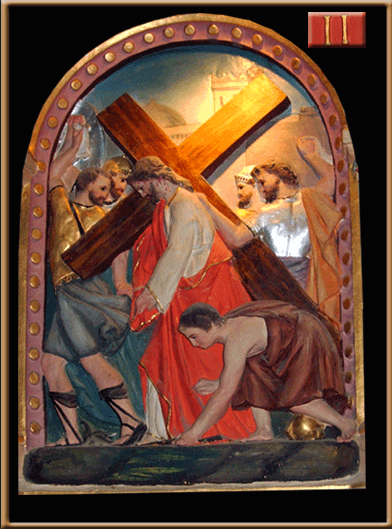 From 1188 onward, the Prieure documents maintain, the Knights Templar were
autonomous - no longer under the authority of the Order of Sion or acting as its
military and administrative arm. Until 1188 the Order of Sion and the Order of the Temple
are said to have shared the same grand master. Hughes de Payen and Bernard de Blanchefort,
for example would have presided over both institutions simultaneously. Commencing in 1188
however the Ordre de Sion reportedly selected its own grand master which was Jean
de Gisors. It also modified its name to Prieure de Sion. And as its subtitle it adopted
the couris name Ormus. Orme is French for elm and 'Or' is gold. The vast treasure
of the Templars somehow stayed with them which lead to Philip III's surpression of the
Templars in 1307. But there are also accounts of some kind of treasure remaining in the
vicinity of Rennes le Chateau.
From 1188 onward, the Prieure documents maintain, the Knights Templar were
autonomous - no longer under the authority of the Order of Sion or acting as its
military and administrative arm. Until 1188 the Order of Sion and the Order of the Temple
are said to have shared the same grand master. Hughes de Payen and Bernard de Blanchefort,
for example would have presided over both institutions simultaneously. Commencing in 1188
however the Ordre de Sion reportedly selected its own grand master which was Jean
de Gisors. It also modified its name to Prieure de Sion. And as its subtitle it adopted
the couris name Ormus. Orme is French for elm and 'Or' is gold. The vast treasure
of the Templars somehow stayed with them which lead to Philip III's surpression of the
Templars in 1307. But there are also accounts of some kind of treasure remaining in the
vicinity of Rennes le Chateau.
The Cutting of the Elm at Gisors did more than just split the Templars off from its parent Order, it defined the boundary line between the Plantagenets on one side, supported by the Templars, and the Capetians on the other, supported by Sion. This division would eventually produce not just the destruction of the Templars by the French King, Philip III and his puppet Pope, Clement V, but the catastrophe of the Hundred Years War between France and England.
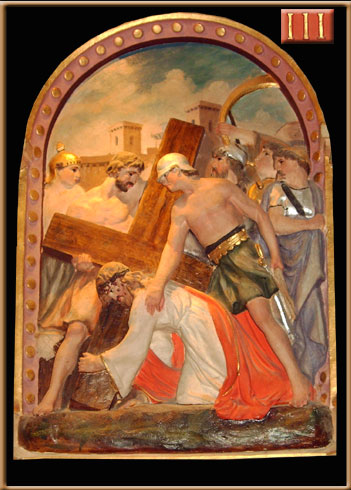 The elm at Gisors represented the Merovingian bloodline, and the battle was about
the claim to the right to rule. Henry II was the grandson of Fulk V, King of Jerusalem.
But this title was bestowed through marriage to the daughter of the previous King of
Jerusalem, Baldwin, who did have a direct male succession from the Merovingian Kings.
The elm at Gisors represented the Merovingian bloodline, and the battle was about
the claim to the right to rule. Henry II was the grandson of Fulk V, King of Jerusalem.
But this title was bestowed through marriage to the daughter of the previous King of
Jerusalem, Baldwin, who did have a direct male succession from the Merovingian Kings.
Henry II's claim to France was based on obscuring the truth; his claim to blood descent was untruthful but politically worth making if the facts could be obscured. However, in a more relevant light, his son Richard did embody a true claim, because his mother, Eleanor of Aquitaine, was descended from Charlemagne and therefore Clovis, one of the first Merovingian Kings. The Plantagenets established their Merovingian heritage only through Eleanor of Aquitaine; it was valid for Richard to make the claim (though he couldn¹t because he wasn¹t yet king), but not for Henry II - even though his grandfather had married the daughter of a legitimate lineal male descendant of the Merovingian line and thus became the third King of Jerusalem after Godfroi and Baldwin.
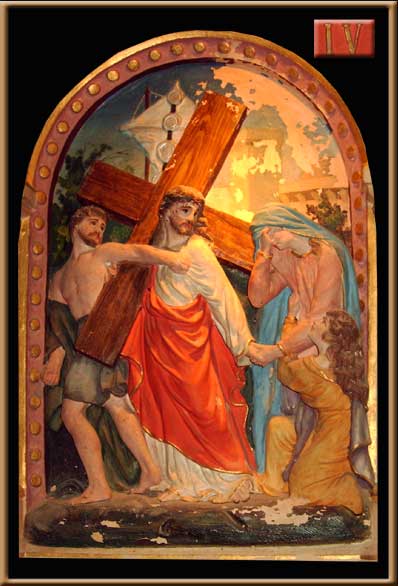 This is why King Phillip of France wanted to symbolically cut the cord from Henry
and Richard: Phillip, too, was descended from Charlemagne. Only two, but more
like three, females stood in the decent line between Phillip and the Merovingian Kings.
(Male descent was preferred in royal successions.) He believed his claim on France
was more pure than the Plantagenet usurpers. (Not true, since Eleanor's other line
back through Bernard Plantevelue was probably all male.) Thus the elm at Gisors,
ancient symbol of genetic branching and direct continuity, was cut as a statement to
Henry II: 'Go away, France is mine!" The outward visible symbol of the 'vine' or bloodline
transplanted from the Holy Land was no more. The knowledge thereafter was
hidden, though preserved by the Templars and, later, by the Priory of Sion.
This is why King Phillip of France wanted to symbolically cut the cord from Henry
and Richard: Phillip, too, was descended from Charlemagne. Only two, but more
like three, females stood in the decent line between Phillip and the Merovingian Kings.
(Male descent was preferred in royal successions.) He believed his claim on France
was more pure than the Plantagenet usurpers. (Not true, since Eleanor's other line
back through Bernard Plantevelue was probably all male.) Thus the elm at Gisors,
ancient symbol of genetic branching and direct continuity, was cut as a statement to
Henry II: 'Go away, France is mine!" The outward visible symbol of the 'vine' or bloodline
transplanted from the Holy Land was no more. The knowledge thereafter was
hidden, though preserved by the Templars and, later, by the Priory of Sion.
Near the end of the thirteenth Century a separate detachment of
Templars was sent from the Aragonese province of Rossillon to the Rennes-le-Château
area in southern France [the old Cathar stronghold]. This fresh detachment
established itself on the summit of the mountain of Bezu,
erecting a lookout post and a chapel.
Alone of all the Templars in France, they were left unmolested by Philippe le Bel's
seneschals on October 13, 1307. On that fateful day the commander of
the Templar contingent at Bezu was a Seigneur de Goth. And before taking the name of
Pope Clement V, the archbishop of Bordeaux - King Philippe's vacillating
pawn - was Bertrand de Goth. Moreover, the new pontiff's mother
was Ida de Blanchefort, of the same family as Bertrand de
Blanchefort [the fourth Grand Master of the Order of the Temple].
Was the pope then privy to some secret entrusted to the custody of his family?"
Baigent, Leigh & Lincoln, Holy Blood, Holy Grail
Architects
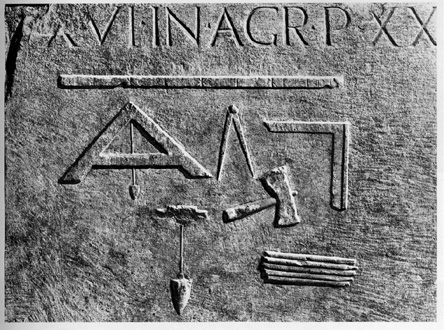 This is the Funeral
Monument of Lucius Alfius Statius. Found in
Aquileia, via Petrada. Underneath the inscription are the seven
tools of a Master Mason. Parallel to the lower edge of the
writing, we see a gauge (regula) with measuring lines for
different distances. Left under it are a setting level and a
plumb bob with cord. The compass (circulus ), square ( norma ),
setting maul (malleus) and five chisels (scalprum) or chalk and
charcoal. Dating from 2-3 generations before
the time of Jesus. The inscription and the carving
are in the Roman Town of Aquileia, one of the most important
Archaeological Sites in Italy.
This is the Funeral
Monument of Lucius Alfius Statius. Found in
Aquileia, via Petrada. Underneath the inscription are the seven
tools of a Master Mason. Parallel to the lower edge of the
writing, we see a gauge (regula) with measuring lines for
different distances. Left under it are a setting level and a
plumb bob with cord. The compass (circulus ), square ( norma ),
setting maul (malleus) and five chisels (scalprum) or chalk and
charcoal. Dating from 2-3 generations before
the time of Jesus. The inscription and the carving
are in the Roman Town of Aquileia, one of the most important
Archaeological Sites in Italy.
...We have thus, then, proof of the early existence of the two sources from which Freemasonry would naturally originate — of the general association and great skill of the eastern architects, and of organized societies, distinguished by peculiar knowledge, by signs, &c., and bound by solemn sanctions not to reveal their secrets to those not initiated. The adoption by the one body of signs, symbols, initiations and mysteries, similar to those of the other was so natural, as almost certain to take place at a very early period of the co-existence of the two societies — the associated craftsmen and the associated mysterymen.
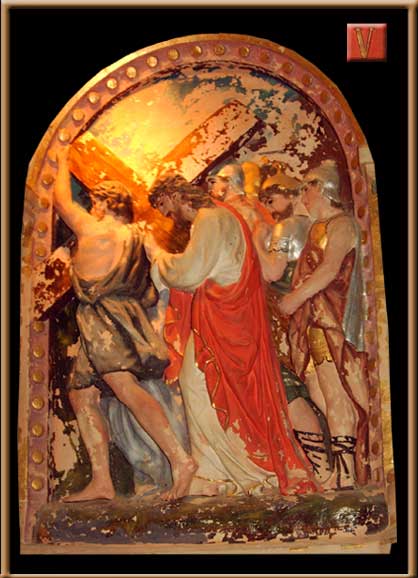 This tendency of all trades or professions to form
separate societies, and to protect their knowledge and rights by
initiation into secrets, by passwords of recognition &c., is not
of modern date, but is coeval almost with history, and indeed arises from
the vary nature of man. The jealousy, too,
with which artistic secrets were guarded, and all unlawful
rivalry checked, may be illustrated by reference to the old
fable of Daedalus, which, perhaps, has been, in another light,
familiar to us from our pleasant school-boy days.
This Daedalus, who is supposed to have lived more than three
thousand years since, and whom some seek to identify with Tubal
Cain, was an artist widely famed for his great ingenuity and skill
in architecture and other kindred sciences.
He was banished from his native country, Athens, for the murder
of his nephew, Talus, who was his pupil, and whose growing genius
so excited his uncle’s jealousy, that he killed him. On his
banishment, he was kindly received by Minos,
king of Crete, and adorned that country with many incomparable
edifices and monuments of his skill. This sounds very much like
the tale of the murder of a student at Rosslin who in his teachers
absence had carved the apprentice pillar exceeding the skill of his master.
This tendency of all trades or professions to form
separate societies, and to protect their knowledge and rights by
initiation into secrets, by passwords of recognition &c., is not
of modern date, but is coeval almost with history, and indeed arises from
the vary nature of man. The jealousy, too,
with which artistic secrets were guarded, and all unlawful
rivalry checked, may be illustrated by reference to the old
fable of Daedalus, which, perhaps, has been, in another light,
familiar to us from our pleasant school-boy days.
This Daedalus, who is supposed to have lived more than three
thousand years since, and whom some seek to identify with Tubal
Cain, was an artist widely famed for his great ingenuity and skill
in architecture and other kindred sciences.
He was banished from his native country, Athens, for the murder
of his nephew, Talus, who was his pupil, and whose growing genius
so excited his uncle’s jealousy, that he killed him. On his
banishment, he was kindly received by Minos,
king of Crete, and adorned that country with many incomparable
edifices and monuments of his skill. This sounds very much like
the tale of the murder of a student at Rosslin who in his teachers
absence had carved the apprentice pillar exceeding the skill of his master.
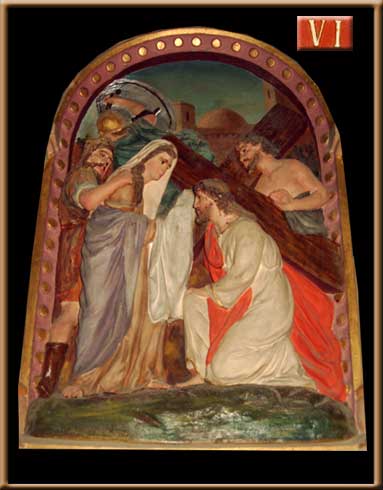 This ancient tale has been explained by the greatest of
modern philosophers, Lord Bacon, “as chiefly denoting the envy
which strangely prevails amongst excellent artificers; for
no kind of people are observed to be more
implacable and destructively envious to one another than these.”
But I am inclined to imagine that a deeper truth lies hid in
this “tradition old and dark,” and that the murder by this mason
of his pupil, which was imputed to his
jealousy of superior skill, was, perhaps, the indignant
punishment inflicted on the youth for divulging the secrets
which he had learned under the instruction of this uncle.
This ancient tale has been explained by the greatest of
modern philosophers, Lord Bacon, “as chiefly denoting the envy
which strangely prevails amongst excellent artificers; for
no kind of people are observed to be more
implacable and destructively envious to one another than these.”
But I am inclined to imagine that a deeper truth lies hid in
this “tradition old and dark,” and that the murder by this mason
of his pupil, which was imputed to his
jealousy of superior skill, was, perhaps, the indignant
punishment inflicted on the youth for divulging the secrets
which he had learned under the instruction of this uncle.
...We may, then, be assured, that at the building of the Temple the skillful masons and architects, whose aid Solomon obtained, did belong to the fraternity I have just referred to and this pointed granted or established, the traditional origin of the re-organization of our even still illustrious and certainly very ancient Order, becomes, if not certain, at least sufficiently probable to receive a willing assent to its truth. The Syrian artificers brought to Jerusalem their science and their mysteries; from Jerusalem, the more illustrious city, these mysteries were propagated as from their original source.
 This supposition receives additional confirmation from
there being then in Judea a very peculiar society of Jews, with
which the Dionysian artificers would readily blend and associate.
This body of Jews were called the Essenes.
Their tenets and distinctive ceremonies bore considerable
resemblance to those of Freemasons; and they, too, had
traditions and duties connected with the Temple. Conflicting
opinions have been entertained by sacred and profane writers as
to the origin of this singular sect — the Essenes; but all concur
in representing them as a very ancient association,
derived too, most probably, from some still more ancient
fraternity, which, at the earliest period of history, existed
in the land of Judea.
This supposition receives additional confirmation from
there being then in Judea a very peculiar society of Jews, with
which the Dionysian artificers would readily blend and associate.
This body of Jews were called the Essenes.
Their tenets and distinctive ceremonies bore considerable
resemblance to those of Freemasons; and they, too, had
traditions and duties connected with the Temple. Conflicting
opinions have been entertained by sacred and profane writers as
to the origin of this singular sect — the Essenes; but all concur
in representing them as a very ancient association,
derived too, most probably, from some still more ancient
fraternity, which, at the earliest period of history, existed
in the land of Judea.
The learned Scaliger, whose research and acuteness are well known, identifies this body with the Assideans or Kasideans, or the most noble Knights of the Temple, who were conspicuous in the glorious times of the Maccabees, and for many ages preceding. The strictest scrutiny was made into the character of every candidate for admission into this fraternity. If he was approved and accepted, a solemn oath was then administered to him, binding him never, even at the risk of life itself, to divulge the secrets of the Order, and he was also instructed in the religious traditions, derived from the earliest founders and members of the sect. They had particular signs by which they could recognise the brethren, and these bore a strong resemblance, as we learn, to those of Freemasons. They, too, were divided into lodges; and while they were honourably distinguished by the severe observance of the moral virtues, they were not neglectful of the social and convivial ties which give zest to life, and bind mankind together by the kindly instincts of human affections.
 This fraternity, which was not confined to architects, thought
the Assideans or restorers of the Temple held
chief place amongst them, continued to flourish at the coming of
our Saviour, and until the fearful destruction
of Jerusalem made the whole nation of jews outcasts,
and even their very name a by-word and reproach. How readily
would these two fraternities — the Dionysian builders
and the Essenes — blend and amalgamate, and give rise to a new
society combining features common to both, or but slight modifications of their
respective peculiarities. This could scarcely fail to take place, and were
history silent on all other mysterious organizations of men professing peculiar
knowledge and distinctive doctrines, the origin of Freemasonry
might, with some confidence, be attributed to, or perhaps more correctly
be termed, a “variety” of the two fraternities of which I have thus
given such a general outline....
This fraternity, which was not confined to architects, thought
the Assideans or restorers of the Temple held
chief place amongst them, continued to flourish at the coming of
our Saviour, and until the fearful destruction
of Jerusalem made the whole nation of jews outcasts,
and even their very name a by-word and reproach. How readily
would these two fraternities — the Dionysian builders
and the Essenes — blend and amalgamate, and give rise to a new
society combining features common to both, or but slight modifications of their
respective peculiarities. This could scarcely fail to take place, and were
history silent on all other mysterious organizations of men professing peculiar
knowledge and distinctive doctrines, the origin of Freemasonry
might, with some confidence, be attributed to, or perhaps more correctly
be termed, a “variety” of the two fraternities of which I have thus
given such a general outline....
from the pages of... The Origin of Freemasonry: A LECTURE. Delivered at the Lodge of Instruction held under the Warrant of The Victoria Lodge, No. IV.,Dublin on Monday, the 2nd of February, 1857 by Robert Longfield, Q.C. In this article is the Proof that the Essenes were Mason's.
Jesus wasn't just a 'Carpenter' of the Craft. He was in all sences of the word a 'Craftsman' or 'Master' and he is identified as such in the King James bible.
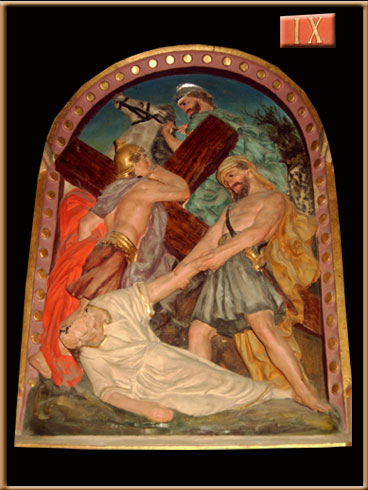 "The true version of the history of Jesus, and early
Christianity was supposedly imparted to Hugh de Payens, by the Grand-Pontiff of the Order of
the Temple (of the Nazarene or Johannite sect), one named
Theocletes, after which it was learned by some Knights in Palestine, from the higher
and more intellectual members of the St. John sect, where were initiated
into its mysteries. Freedom of intellectual thought and the restoration of one and
universal religion was their secret object. Sworn to the vow of obedience, poverty,
and chastity, they were at first the true Knights of John the Baptist, crying in the
wilderness and living on wild honey and locusts. Such is the tradition and the true
kabalistic version."
"The true version of the history of Jesus, and early
Christianity was supposedly imparted to Hugh de Payens, by the Grand-Pontiff of the Order of
the Temple (of the Nazarene or Johannite sect), one named
Theocletes, after which it was learned by some Knights in Palestine, from the higher
and more intellectual members of the St. John sect, where were initiated
into its mysteries. Freedom of intellectual thought and the restoration of one and
universal religion was their secret object. Sworn to the vow of obedience, poverty,
and chastity, they were at first the true Knights of John the Baptist, crying in the
wilderness and living on wild honey and locusts. Such is the tradition and the true
kabalistic version."- M. P. Blavatsky, Isis Unveiled
Athelstan, the grandson of Alfred the Great, ruled England from 924 til 940 A.D. The Regius Poem and other ancient legends say he was a great patron of Masonry. He studied geometry and imported men of these and other arts so as to preserve the craft. He issued a charter to the Masons to hold a yearly assembly at York and he made many masons. The king appointed his brother Edwin to be the First Grand Master in York in 926 at which time they held the first Grand Lodge Meeting. They based their laws and regulations for the craft on the Regius Poem as there are fifteen points dealing with ethical, moral and spiritual responsibilities of the ancient craftsmen.
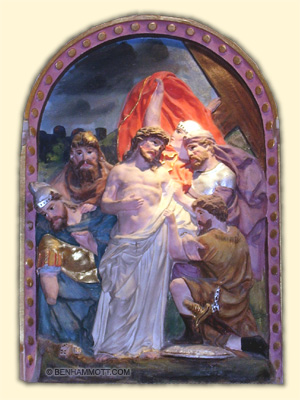 "A knight must be merciful without wickedness, affable without
treachery, compassionate towards the suffering, and open handed.
He must be ready to help the needy and to confound robbers and
murderers, a just judge without favour or hate. He must prefer
death to dishonour. He must protect the Holy Church for she
cannot defend herself."
"A knight must be merciful without wickedness, affable without
treachery, compassionate towards the suffering, and open handed.
He must be ready to help the needy and to confound robbers and
murderers, a just judge without favour or hate. He must prefer
death to dishonour. He must protect the Holy Church for she
cannot defend herself."- Chrétien de Troyes, Lancelot (Vulgate Cycle)
The real Secret Society ..or is it?
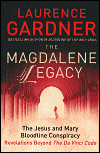 With the release of Dan Brown's Da Vinci Code and the movie
now released, we offer the jest of the investigation by
Holy Blood, Holy Grail which Dan Brown has admitted using as the
background of his book. However this story has been circulating for
centuries from other sources and Holy Blood-Holy Grail was not
the only source. As of April 7th, 2006 Dan Brown has successfully
defended himself in this court case. However in the book, Dan Brown states
that some things are 'fact', when they are not. Neither Dan Brown, or the
authors of Holy Blood Holy Grail are Masons. The book we show here details
what is fact and what is not according to the historical record. This book also
details historical information about the Merovingian dynasty in France
and it's link to Mary Magdalene and Jesus. Laurence Gardner is a Mason and a member of
The Knights Templar of St. Anthony.
With the release of Dan Brown's Da Vinci Code and the movie
now released, we offer the jest of the investigation by
Holy Blood, Holy Grail which Dan Brown has admitted using as the
background of his book. However this story has been circulating for
centuries from other sources and Holy Blood-Holy Grail was not
the only source. As of April 7th, 2006 Dan Brown has successfully
defended himself in this court case. However in the book, Dan Brown states
that some things are 'fact', when they are not. Neither Dan Brown, or the
authors of Holy Blood Holy Grail are Masons. The book we show here details
what is fact and what is not according to the historical record. This book also
details historical information about the Merovingian dynasty in France
and it's link to Mary Magdalene and Jesus. Laurence Gardner is a Mason and a member of
The Knights Templar of St. Anthony.
 Our latest read by Lynn Picknett and Clive Prince digs much deeper into the Sion
Mystery and the relationship of Leonardo da Vinci with The Priory of Sion.
There is a connection. The critics say; that the Priory is a hoax, but one that is carefully
designed in the manner of misinformation leaked by intelligence agencies to achieve specific
goals. Behind the hoax, they say, is a network of European esoteric societies driven by the
principle of "synarchy" and influencing the coalescence of the European Union, perhaps
at the expense of democracy.
Our latest read by Lynn Picknett and Clive Prince digs much deeper into the Sion
Mystery and the relationship of Leonardo da Vinci with The Priory of Sion.
There is a connection. The critics say; that the Priory is a hoax, but one that is carefully
designed in the manner of misinformation leaked by intelligence agencies to achieve specific
goals. Behind the hoax, they say, is a network of European esoteric societies driven by the
principle of "synarchy" and influencing the coalescence of the European Union, perhaps
at the expense of democracy.
Picknett and Clive find no evidence of a secret society that might be connected to Mary Magdalene or the Knights Templar but we don't think they were looking very hard. What they did find was alot of influential people that obviously belonged to a secret society or were connected at one time to Rennes-le-Chateau or knew Plantard. This leaves lots of holes in their theories that the Dossier documents are a complete hoax. They themselves admit that another Grand Master list popped up from the research by Laurence Gardiner - Bloodline of the Holy Grail and except for a few lines, matches the list discovered by Baigent, Lincoln and Leigh and susposedly faked by Plantard..
An old society called Priory of Sion was dedicated to reestablishing the Merovingian dynasty in France. This family, it is said, are direct decendents of Mary and Jesus.
This family was the power behind the secret Order of the Rosy Cross. Priory was traced back to the gnostic adept Ormus, who lived in the first century AD, and was a contempoary of Mark. The red cross symbol was adopted by the Templars and was also the cross of the medieval Rosicrucians. The Templars also had a close association with the Assassin Order and Sufis, both of whom possessed mystical secrets. - Henry Lincoln and his co-authors of Holy Blood, Holy Grail and others fashioned a theory that Christ had descendents who "legged it to the south of France where they intermarried with the royal Franks to found what eventually became the mystical Merovingian Dynasty.
 The Priory of Sion is still in existance in underground streams ( highly
secret circles )and has in it ranks some of the richest most influential
families in France. These families are ever and always
seeking the throne they say, was once quaranteed by their
bloodlines. Amoung the Grand Masters were; Leonardo da Vinci,
Robert Boyle, Isaac Newton, Victor Hugo, and Claude Debussy and
Jean de Gisors in 1188, and Jean de Saint-Clair in 1351.
The Priory of Sion is still in existance in underground streams ( highly
secret circles )and has in it ranks some of the richest most influential
families in France. These families are ever and always
seeking the throne they say, was once quaranteed by their
bloodlines. Amoung the Grand Masters were; Leonardo da Vinci,
Robert Boyle, Isaac Newton, Victor Hugo, and Claude Debussy and
Jean de Gisors in 1188, and Jean de Saint-Clair in 1351.
A Female Grand Master, Marie de Saint-Clair in 1220, and Blanche d'Evreus, in 1366. Members also included a Cardinal named Richelieu in 1633..The Grand Masters are said to carry the 'royal blood' of David.
Michael Baigent, Richard Leigh, and Henry Lincoln, Holy Blood, Holy Grail
We found evidence that Pope Saint Gregory I or Gregory the Great (ca. 540 - March 12, 604) formed an alliance with the Benedictine abbots and with the Merovingian kingdoms of the Franks. So this Dynasty did infact exist and still does. However it is this Pope Gregory who saw to it that Mary Magdalene was labeled a prostitute. Why does this sound like an attempt to 'cover up' something?
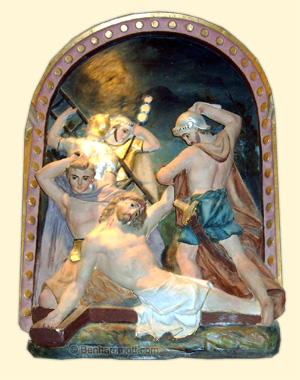 The time frame seems to match up with the murder of
Dagobert II, King of all the Franks in 679. His son Sigebert was
hidden in the Languedoc region in the south of France specifically in what
is today the Legendary village of Rennes-le-Chateau. Evidence surfaces that
the Order of Sion, a secret organization formed at the end of the 11th century
to advance the bloodlines interests did in fact exist. Its first leader was
none other than Godefroy de Bouillon, one of Dagobert's descendents.
The time frame seems to match up with the murder of
Dagobert II, King of all the Franks in 679. His son Sigebert was
hidden in the Languedoc region in the south of France specifically in what
is today the Legendary village of Rennes-le-Chateau. Evidence surfaces that
the Order of Sion, a secret organization formed at the end of the 11th century
to advance the bloodlines interests did in fact exist. Its first leader was
none other than Godefroy de Bouillon, one of Dagobert's descendents.
Ergo; "The real mission of the Templars and Priory of Zion: "To safeguard not just the treasure of the Crusades, but to preserve the Grail, which appeared in medieval texts as 'Sangraal' or 'Sang réal', and which Lincoln et al. translated to mean sang réal, or 'royal blood'. In other words: the dynastic legacy of Christ, literally." "...The Royal bloodline."
The Merovingians were considered in their day to be quasi-mystical warrior-kings vested with supernatural powers." However this, it is said, this has been proven to be a great hoax by some. They contend that.. The Priory de Sion is a modern association, having been formed in France in 1956. Some writers say its alleged links to the medieval Order of Sion have been placed in doubt with the so-called admission that key historical documents are fraudulent. An independent investigation over a twelve year period by the writers of Holy Blood, Holy Grail shows considerable evidence that it is not.
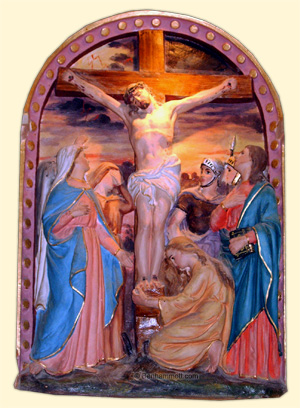 Could it be that Plantard, in an attempt to retract his statements
admitted to a hoax so that the curious would back off? And does that mean
the Priory is real and he was a member? While not proving there is still an organization,
on the next page you will find another descendent, still living and able to confirm
the Merovingian bloodline. This person lives in the U.S.A.
Could it be that Plantard, in an attempt to retract his statements
admitted to a hoax so that the curious would back off? And does that mean
the Priory is real and he was a member? While not proving there is still an organization,
on the next page you will find another descendent, still living and able to confirm
the Merovingian bloodline. This person lives in the U.S.A.
We agree with this as too many other references are
found to be correct and can be traced to their origin. Holy
Blood, Holy Grail found that the documents are kept at
Bibliotheque Nationale and are known as 'the secret Dossiers'.
The authors disguise themselvs but seem to have accurate
information in the documents. One living identifiable member,
Pierre Plantard spoke in 1960 of an "international secret",
when interviewed by Gerard de Sede. This secret is concealed
at Gisors. Mr Plantard signs himself as 'Prieure Plantard
de Saint-Clair'. Mr. Plantard claims he is a lineal descendent of
King Dogobert and the Merovingian dynasty. According to
the same genealogies, he is also a descendent of the owners
of Chateau Barberie, the property destroyed by Cardinal Mazarin
in 1659. According to recent disclosures, Mr. Plantard's grandfather
was a personal acquaintance of Berenger Sauniere who was the priest
that lived at the church at Rennes-le-Chateau.
Baigent, Leigh and Lincoln, Holy Blood, Holy Grail,
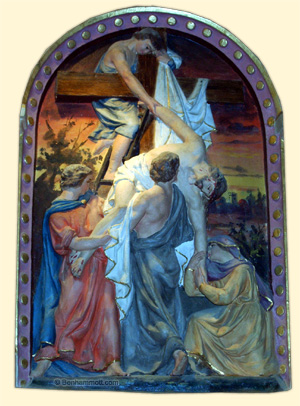 A post book investigation shows Plantard to have been arrested and
convicted of corruption of minors, and in 1993 documents were found in his home
claiming him to be the "true King of France". A judge reprimanded him for playing
games but no laws had been broken so he was released. He died in 2000.
However more information surfaces in The Sion Revelation
by Picknett and Prince. Plantard may have connected himself with this
organization but that doesn't mean the organization itself is a hoax.
A post book investigation shows Plantard to have been arrested and
convicted of corruption of minors, and in 1993 documents were found in his home
claiming him to be the "true King of France". A judge reprimanded him for playing
games but no laws had been broken so he was released. He died in 2000.
However more information surfaces in The Sion Revelation
by Picknett and Prince. Plantard may have connected himself with this
organization but that doesn't mean the organization itself is a hoax.
"Pierre Plantard de Saint-Clair [was] apparently the source
behind much of the recent literature devoted to the hilltown
and its enigmatic priest. Shepherded to Paris's Bibliotheque Nationale, a trio of
historical investigators [ Baigent, Leigh & Lincoln, Holy Blood, Holy Grail ]
discovered there a provocative genealogy purporting
to link Pierre Plantard to King Dagobert II and the Merovingian dynasty.
"Throughout these Dossiers Secrets at Paris's national library
were tantalizing historical references to a mysterious and
ancient secret society called Prieure de Sion, or Priory of Zion."
Baigent, Leigh and Lincoln, Holy Blood, Holy Grail,
Mr Plantard seems to own a number of tracts of land in the
vicinity of Rennes-le-Chateau. Mr. Plantard was listed as secretary
-general of the Prieure de Sion.
Depending on what statutes one considers, Sion either has
9,841 members in nine grades, or 1,093 members in seven, with
the supreme member, the 'Nautonnier' or Grand Master of the
Order being, till 1963, Jean Cocteau.
While it is believed the head has been Pierre Plantard de
St.Clair up until recent times, he claims to have left that
post in 1984, but a man named Sandri runs the organization at
this time. When Plantard resigned, the organization's members
were issued orders from Plantard to denigh their membership
or of even knowing of it's existance. He also indicated that
there were American and European members who wished to 'change
the direction' or priority of the group, which he strongly
disagreed with, and this may be the reason he exposed them.
Older documents described in the Messianic Legacy, by Lincoln, Baigent, Leigh indicate another chivalric order called Alpha Galates which was in existance before 1942. M. Plantard, then called Pierre de France Plantard was made Grand Master of this order. This order is described as a 'Grand Order of Chivalry' in the service to the homeland. In the pages of a publication called Vaincre there was occasional ugly anti-Semitic statements which echo the ravings of Nazi propaganda. "To restore our homeland to its rank it is necessary to eradicate false dogmas and the corrupt principles of the formerly democratic Jewish-Masonry."
At the time France was occupied by Germany and the explanation of this was that there were coded messages in these publications meant to confer instructions to the Resistance.
Tracing the documents backwards in time suggests that the
Knights Templar were actually formed in 1109 from the Priory
of Sion group. The group says, they have incontrovertible proof of the bloodline.
Baigent, Leigh and Lincoln, Holy Blood, Holy Grail
In a 1973 interview Plantard said, "The society to which I
belong is extremely ancient. I merely succeed others, a point
in a sequence. We are guardians of certain things. And without
publicity".
Baigent, Leigh and Lincoln, Holy Blood, Holy Grail,
During the fifth century this lineage appears to have intermarried with the royal line of the Franks, thus engendering the Merovingian dynasty. In A.D. 496 the Church made a pact with this dynasty, through a man named Clovis, pledging itself in perpetuity of the Merovingian bloodline - presumably in the full knowledge of that bloodline's true identity.
This would explain why Clovis was offered the status of
Holy Roman Emperor, of "new Constantine," and why he was not
created king but only recognized as such.
Baigent, Leigh and
Lincoln, Holy Blood, Holy Grail,
The Merovingian' territories spilled into what is now Belgium and parts of the Netherlands and Germany. The Franks lands were also in Austrasia, Burgundy, and Neustria. A Duke named Hautpoul and many many other prominent figures are connected together in this mystery.
In the book, Beyond the Da Vinci Code by Sangeet Duchane, 'Another association' not named, claims that the Merovingians were the true kings of France, usurped by the Carolingians (ca. 751) with the treacherous aid of the Vatican. When Charlemage, the most famous of the Carolingians, was crowned Holy Roman Emperor, on Christmas day 800, the pope is said to have given him a blue banner with gold fleurs-de-lis, and this symbol continued to be a symbol of French royality long afterward. This wouldn't be important if it weren't linked to the Vatican and a pope. Most people know that it was King Philipe of France and his puppet French pope Clement V, who colluded in the arrest of the Templars on October 13th, 1307.
When the church colluded in Dogobert II's assassination and
the subsequent betrayal of the Merovingian bloodline, it
rendered itself guilty of a crime that could not be rationalized
nor expunged. It could only be supressed. It would have had
to be supressed - for a disclosure of the Merovingian's real
identity would hardly have strengthened Rome's position
against her ememies.
Baigent, Leigh and Lincoln, Holy Blood, Holy Grail,
"'Sang réal' has been traditionally interpreted as the
'holy grail' which, according to legend, Mary Magdalen carried to the
Jewish kingdom of southern Gaul (including Rennes-le-Château.) It was
believed by adherents of a secret tradition that Mary Magdalene was the wife of Jesus
and that what she brought was not a vessel but the royal seed of David in her womb."
- Jonathan Vankin and John Whalen, "Descendants of Jesus
? Or Scam Artistes Extraordinaire?"
![]() "Up until
recently, little was known about these long-haired kings, as they inhabited that
historical epoch derided as the 'Dark Ages'. The founder of the royal line,
Merovech, was said to be of two fathers - his mother, already pregnant by King
Chlodio, was seduced while swimming in the ocean by a 'Quinotaur,' whatever that
was, and Merovech was formed somehow by the co-mingling of Frankish blood and that
of the mysterious aquatic creature. Like the Nazoreans of old, the Merovingian monarchs
never cut their hair, and bore a distinctive birth-mark -
"Up until
recently, little was known about these long-haired kings, as they inhabited that
historical epoch derided as the 'Dark Ages'. The founder of the royal line,
Merovech, was said to be of two fathers - his mother, already pregnant by King
Chlodio, was seduced while swimming in the ocean by a 'Quinotaur,' whatever that
was, and Merovech was formed somehow by the co-mingling of Frankish blood and that
of the mysterious aquatic creature. Like the Nazoreans of old, the Merovingian monarchs
never cut their hair, and bore a distinctive birth-mark -
said to be a red cross over (or between) the shoulder blades.
Their robes were fringed with tassels which were said to carry magical
curative powers. They were known as occult adepts, and in one Merovingian tomb was found
such items as a golden bull's head, a crystal ball, and several golden miniature bees.
And strangely, many skulls of these monarchs appear to have been ritually incised - i.e.
trephanned."
- Steve Mizrach, "The Mysteries of Rennes-le-Château and
the Prieure du Sion"
The Merovingians traced their ancestry back to the Benjamites who, according to legend, had fled from Israel to Arcadia in Greece. "One of the more mysterious footnotes in history is the story of the Principality of Septimania. Granted by Peppin III to the large Jewish population in the south of France, its first king, Theodoric, claimed descent not only from the Merovingian Kings, but lineal descent from King David himself. This may be Dogobert ( King of the Franks 630) I's son, Sigisbert III, who was king of Austrasia in 632.
Both the king and the Pope acknowledged this pedigree. His son, Guillem de Gellone, was a great, almost legendary hero about whom no less than six medieval epics were written, including 'Wilehalm' by Wolfram von Eschenbach. He is closely linked with the Grail family. His descendant, 17 generations later, was Godfroi de Bouillon, leader of the First Crusade. The ancestory of Godfroi Bouillon has been traced to the lost tribe of Benjamin.
The tribe of Benjamin, whose original name was Benoni, a name given to him
by his mother Rachel, before she died. The record also indicates that when Moses
appointed the lands to the twelve tribes, the territory of what
is now Jerusalem belonged to the Benjamites. The capital city
was the birthrite of Solomon and King David. A Map of this
division is on..
Death of the disciples
..automatic scroll down.
The earliest roots of the Prieure de Sion are in some sort
of Hermetic or
Gnostic
society led by a man named Ormus. This individual is said to have reconciled paganism
and Christianity. The story of Sion only comes into focus in the Middle Ages. In
1070, a group of monks from Calabria, Italy, led by one Prince Ursus, founded the
Abbey of Orval in France near Stenay, in the Ardennes. These monks are said to have
formed the basis for the the Order de Sion, into which they were 'folded' in 1099 by
Godfroi de Bouillion." "The avowed and declared objective of the Prieure de Sion
is the restoration of the Merovingian dynasty and blood-line - to the throne not only
of France, but to the thrones of other European nations as well."
"By dint of dynastic alliances and intermarriages, this line came to include Godfroi de
Bouillion. - Jonathan Vankin and John Whalen, "Descendants of Jesus?
Or Scam Artistes Extraordinaire?"
In a post script explaination, Lincoln, Baigent and Leigh recorded this; Our first inkling that Napoleon was connected with this story came with the numerous references in the Dossiers genealogies, which noted among their sources the work of an Abbe Pichon. Between 1805 and 1814 Pichon completed a study of the Merovingian descent from Dagobert II until November 20, 1809, when Jean XXII des Plantard was born in Semélay (Nievre). His sources were stated to be documents discovered following the French Revolution. Additional information was contained in the Alpina publication of Madeleine Blancasall, which stated (p. I) that Abbé Pichon was commissioned by Sieyès (Official of the Directory, 1795-99) and Napoleon. A comprehensive body of material is contained in L’Or de Rennes pour un Napoleon by Philippe de Cherisey, which is now on microfiche at the Bibliothéque Nationale, Paris. Briefly, Cherisey says that the Abbé Sieyès, via Pichon’s researches on the captured royal archives, knew of the survival of the Merovingians. He told the story to Napoleon, whom he then urged to marry Josephine, the ex-wife of a Merovingian descendant, Alexandre de Beauharnais. Napoleon later adopted her two children, who carried the ‘blood royal.'
Later Napoleon commissioned Abbé Pichon (whose real name is said to be François Dron) to complete a definitive genealogy. Napoleon was interested, among other things, in the indications that the Bourbon dynasty was in fact illegitimate. And his coronation as Emperor of the French (not of France), in a ceremony with significant Merovingian resonances, is said to be a result of Sieyes’ and Pichon’s studies. If this is so, Napoleon was setting up the foundation for a renewed Merovingian empire. Being childless by Josephine, he then married Marie Louise, the daughter of the Hapsburg Austrian Emperor, of Merovingian descent. She bore his son, Napoleon II, who carried the ‘blood royal' of the Merovingians. ‘The latter, however, died childless. But the future Napoleon 111, son of Louis Bonaparte and Hortense de Beauhamais (daughter of Josephine by her first marriage) also carried the “blood royal.”
Cherisey also implies coyly that Archduke Karl (brother of Napoleon’s wife) was
bribed to lose the battle of Wagram in 1809 in exchange for part of the Merovingian
teasure, which Napoleon had found in the Razes, This Treasure was later discovered at
Petroassa in 1837, then a Hapsburg domain. Given the Merovingian descent of the
Hapsburgs, it is clear why they would value it.
Baigent, Leigh and Lincoln, Holy Blood, Holy Grail, p-466
In order to give the 'opposite side of the story', we found this
site by Paul Smith.
Rennes-le-Château Papers of Paul Smith
However we are inclined to believe the story in Holy Blood, Holy Grail
because of the documents they ( Lincoln, Baigent and Leigh ) found and the article
and statements of Plantard de Saint-Clair even though he is called a charlatan by Smith.
As we mentioned, other researchers have found similiar documents and a historical record.
More of this record emerges on the next page.
To quote Smith this statement says it all, "...
"I immediately recognised that the so-called researches on the New Testament were very
much a 'rush job' and that the authors did not even know some of the basic facts
relating to Christianity."
In dispute of this; ( They are self proclaimed Christians, they
therefore would do anything to discredit the Prieure de Sion story.) The research
conducted by Lincoln, Baigent and Leigh covered a twelve year period. It has
nothing to do with Christianity except the exposure
of a fraud created in or about 52 A.D. when paul portrayed
himself as a disciple and infiltrated the Essene order. They
did indeed find facts in Acts as we did, that clearly indicate the destruction
of the true teachings of Jesus and the elimination or escape
of the disciples which included Mary Magdalene. This is also backed up by certain elements
in the Nag Hammidi Scrolls, the history of Rome and the occupation
of Israel, the writings of Josephus, as well as the Dead Sea
Scrolls which we elaborate on on our pages about the real life
of Jesus. Our 'Passage' pages offer exerpts of the Scrolls. In particular we reference
the Gospel of Philip and the
The Second Treatise of the Great Seth
from the Nag Hammidi scrolls.
Circumstantial evidence it is, but Scott Petterson was given the death penality on nothing but circumstantial evidence.
For many people, the evidence that the Priory has lied-ever, on any subject-automatically means that it can be dismissed out of hand. But this attitude ignores some major aspects of the conundrum.
The Priory of Sion was not the sole invention of Pierre Plantard, nor was he its one and only member. Even if it was all a fraud, he had co-conspirators. He never worked alone: when the Priory made its first appearance in official records in 1956, there were at least three others involved. Plantard’s most famous collaborator, from the early l960s until his death in 1985, was Philippe, Marquis de Chérisey. And the Priory has survived Plantard: it continues to operate under its general secretary, Gino Sandri, who first met Plantard in the early 1970s and has been in- volved with the Priory since 1977. Any theory that seeks to explain the Priory away as a hoax of Plantard’s also has to account for the involve ment of these people-and many others.
Plantard and his companions maintained the deception for more than thirty years, with considerable effort. Yet nobody, not even Paul Smith, has been able to offer a satisfactory reason for such a tenacious and prolonged scam. The most obvious motive-money-can be discounted. Not only is there no evidence that Plantard made anything but modest sums from the affair, but there are occasions on which he could have capitalized on it but signally made no attempt to do so. If he was solely a con man, why didn’t he just forget it and move on to something much more lucrative?
In fact, it would have been only too easy to turn the Priory of Sion into a moneymaking machine...but it was not. Few self styled orders have been in such a perfect position to exploit gullible wounder seekers as the Priory was after the success of Holy Blood Holy Grail - yet Plantard not only failed to do so but actually backed off as more and more interest in the society was generated.
"Certain writers have suggested that the Templars were 'infected' with the
Johannite or Mandaean heresy - which denounced Jesus as a 'false prophet'
and acknowledged
John [the Baptist]
as the true Messiah. In the course of their activities in the
Middle East the Templars undoubtedly established contact with
Johannite sects".
Baigent, Leigh and Lincoln, The Holy Blood - Holy Grail
"The Grand-Pontiffs of this sect [the Johannites] took the title of Christ, and
laid claim to an unbroken chain of succession in their office.
At the time of the foundation of the Order of the Temple (AD 1118), the Grand-Pontiff
was named Theocletes; he was acquainted with Hugo de Payens and initiated him into
the mysteries and privileges of his Church, promising him the sovereign priesthood
and supreme government, finally designating him as his successor."
- Kenneth Mackenzie, The Royal Masonic Cyclopaedia
According to the Dossiers Secrets, the following individuals
were amongst the Grand Masters of the Ordre de Sion:
Jean de Gisors 1188-1220
Marie de Saint Clair 1220-1266
Guillaume de Gisors 1266-1307
Edouard de Bar 1307-1336
Jeanne de Bar 1336-1351
Jean se Saint-Clair 1351-1366
Blanche d' Evreux 1366-1398
Nicholas Flamel 1398-1418
Rene d' Anjou 1418-1480
Iolande de Bar 1480-1483
Sandro Filipepi 1483-1510
Leonardo da Vinci 1510-1519
Connetable de Bourbon 1519-1527
Ferdinamd de Gonzague 1527-1575
Louis de Nevers 1575-1595
Robert Fludd 1595-1637
J.Valentin Andrea 1637-1654
Robert Boyle 1654-1691
Isaac Newton 1691-1727
Charles Radclyffe 1727-1746
Charles de Lorraine 1746-1780
Maximillian de Lorraine 1780-1801
Charles Nodier 1801-1844
Victor Hugo 1844-1885
Claude Debussy 1885-1918
Jean Cocteau 1918- ?
Plantard was criticized for including some very famous and influencial people in the list, but some of these people we know very little about, and that alone provides reason to consider the list isn't fake. This is what we do know about some of these Grand Masters....
René d'Anjou (1418-80) - a major impetus behind the Renaissance through his literacy and influence on Cosimo de'Medici setting up bastions of esoteric, Hermetic principles - the 'underground stream'. Legend records that the d'Anjous were descended from Ann the Jew, daughter of Joseph of Arimathea, who supposedly carried the Davidic blood line and settled in western France.
Later, the D'Anjou branched into the Houses of De Guise and De Lorraine. Through his patronage of art, literature and the advancement of knowledge Rene is one of the most important figures of the formative years of the Renaissance. It was directly as a result of Rene's influence that Cosimo de Medici sent agents out to look for ancient texts, which resulted in the revival of Neoplatonic and Hermetic thought.
René d'Anjou was related to the king of France by marriage and remained a trusted
ally during the war with England. On paper, René was one of the most powerful men in
Europe. Unfortunately, after the failure of his Italian campaign, he was nothing more
than a patron of the arts and collector of books. René was co-sponsor of the Arcadia
revival in the late 15th century.
enoch@execulink.com
Nicholas Flamel (1330-1418) - Most famous of the alchemists; the Paris notary Nicolas Flamel... claimed that he dreamed of an occult book, subsequently found it, and succeeded in deciphering it with the aid of a Jewish scholar learned in the mystic Hebrew writings known as the Kabbala. In 1382 Flamel claimed to have succeeded in the 'Great Work' (gold making); certainly he became rich and made donations to churches. Revered by men like Newton, Flamel was the discoverer of The Sacred Book of Abraham the Jew, Prince, Priest, Levite, Astrologer and Philosopher to that Tribe of Jews who by the Wrath of God were Dispersed amongst the Gauls, which became one of the most famous works in Western esoteric tradition..
Sandro Filipepi (1483-1510) -
better known as Botticelli, the renowned Renaissance painter.
Botticelli's Primavera is a complex Neo-Platonic allegory,
drawing on some verses by Politian. Mercury, who is Reason,
is plucking fruit from a tree; so young Lorenzo's reason will
come to fruition if united with humane culture. The Three Graces
are dancing: they are Splendor, Youth, happiness, or Grace,
Beauty, Faith. Their threeness speaks of Christian mystery.
At the same time they are associated with Venus; Pico speaks of
the division of the unity of Venus into the Three Graces. Over
Venus's head Cupid aims at these three; they too must aspire to
God through love. On the other side Zephyrus, the
West Wind, comes from the sun's setting with the nymph Flora,
who is transformed into the serene goddess with the flowery
dress. A picture of spring, then, but symbolizing the awakening
of the love of God through humane culture.
John Ferguson, An Illustrated Encyclopaedia
of Mysticism and the Mystery Religions
Other famous Botticeli paintings include The Birth of Venus
and Mars and Venus
Leonardo de Vinci (1510-19) - Having little formal education, Leonardo enthusiastically accepted Nicholas's [of Cusa] new worldview [of an universe with no limits in space, no beginning or ending in time] as a justification for rejecting the outmoded authority of the 'pharisees - the 'holy friars' and of his 'adversaries' Plato and Aristotole. For the first time since the Ionians, he put forward a conception of science that was wholly secular, in no way based on religious doctrines or philosophy....In Leonardo the craftsman, scientist, and inventor are merged into one. Eric Lerner, The Big Bang Never Happened
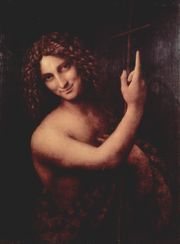 Leonardo was left-handed; he was a strict vegetarian; he dissected dead
bodies, he sought the company of alchemists and necromancers; he worked on a
Sunday and only attended Mass when at court.
Leonardo was left-handed; he was a strict vegetarian; he dissected dead
bodies, he sought the company of alchemists and necromancers; he worked on a
Sunday and only attended Mass when at court.The only surviving sculpture that involved Leonardo in its making is the statue of John the Baptist in the Baptistry in Florence, on which he collaborated with the utmost secrecy with Giovan Francesco Rustici, a known necromancer and alchemist. And Leonardo's last painting was 'John the Baptist', showing him with the same half-smile as 'The Mona Lisa', and pointing straight upwards with the index finger of his right hand. This in Leonardo's work is a sign always associated with John: in the 'Adoration of the Magi' a person stands by the elevated roots of a carob tree - John's tree, symbol of sacrifical blood - while making this gesture. In his famous cartoon of St. Anne the subject also does this, warning an oblivious Virgin...The disciple whose face is perhaps accusingly close to Jesus' in 'The Last Supper' is also making this gesture. All these gestures are saying 'remember John'.
Lynn Picknett & Clive Prince, Turin Shroud - In Whose Image? The Shocking Truth Unveiled
Da Vinci's latter-day connection comes from the order of the Rose-Cross of the Temple and Grail (Ordre de la Rose-Croix du Temple et du Graal), of which Josephin Peladan became Grand Master in 1891. The order was an offshoot of the Masonic La Sagesse lodge of Toulouse, in which the Hautpoul family were prominent.
Robert Fludd (1595-1637) -He is perhaps the most famous and well documented of
medievel alchemists. A seventeenth century philosopher, was an exponent of Hermitic
thought and other arcane subjects. He inherited John Dee's mantle as England's
leading exponent of esoteric thought who consorted with Andrea, amongst others
involved in the 'Rosicrucian' movement.
Historian Frances Yates, in her book The Rosicrucian Enlightenment,
in a chapter entitled 'Rosicrucianism and Freemasonry', quotes one De Quincey,
who states, 'Freemasonry is neither more nor less than Rosicrucianism as
modified by those who transplanted it in England, whence it was re-exported to
the other countries of Europe.' De Quincey states that Robert Fludd was the
person most responsible for bringing Rosicrucianism to England and giving it its
new name.
Gerry Rose ,The Venetian Takeover of
England and Its Creation of Freemasonry
Johann Valenin Andrea (1637-54)
the creator of the semi-secret Christian unions and author of the
Rosicrucian manifestos, a Hermetic allegory which also evokes resonances with
the Grail Romances and the Knights Templar. At this time, with the eclipse of
the House of Lorraine, the Priory transferred its allegiance to the more
influential Stuarts after Frederick of the Palatinate married Elizabeth Stuart,
daughter of James I of England. Frederick created a culture, a
'Rosicrucian' state with its court centered on Heidelberg. [Francis Yates]
Baigent & Leigh, The Holy Blood and the Holy Grail
Through the historical detective work of Frances Yates, we now know
that this era was a time when many 'Rosicrucian' ideas were moving to the
Continent, and esoteric thinkers were confluencing around Frederick, Elector of
the Palatinate of Bohemia, as the figure who would usher in the reforms of
Church and State many expected.
Steve Mizrach, The Mysteries of Rennes-le-Château
and the Prieure du Sion
Robert Boyle (1654-91) - part of the Invisible College of dynamic English and European minds which became the Royal Society after the restoration of the monarch in 1160 with the Stuart ruler, Charles II as its patron and sponsor. His two closest friends were Isaac Newton and John Locke who met regularly with him to study alchemical works.
In the ancient world alchemy was referred to simply as 'the sacred
art'. It flourished in the first three centuries A.D. in Alexandria, where it
was the combined product of glass and metal technology, a Hellenistic philosophy
of the unity of all things through the four elements (earth, air, water, fire),
and 'occult' religion and astrology....The essential principle was that all
things, both animate and inanimate, were permeated by spirit, and that the
substances of the lower world could, through a synthesis of chemical operations
and imaginative reasoning, be transmuted into higher things of the spiritual
world - things not subject to decay.
David Maybury-Lewis, Millenium
The central idea of Gnosticism is that the material of which 'soul and
true being' is composed is trapped through a series of cosmic misfortunes in a
low-level universe that is alien to it. And the alchemists literalized these
ideas to suggest that the spirit could somehow be distilled or coaxed from the
dense matrix of matter.
Terence McKenna, The Archaic Revival
Isaac Newton (1691-1727) believed alchemy might enable human beings to
shape and control the world by understanding and participating in its God-given
vitality. He conducted alchemical experiments with great secrecy at Trinity College,
Cambridge, working alone, even building his own furnaces without the aid of a bricklayer.
He made a pact with the chemist John Boyle not to communicate their shared alchemical
knowledge to others, because the 'subtle' and 'noble' powers of matter and the
means of controlling them should be kept secret by those chosen by God to be
entrusted with them.
David Maybury Lewis, Millenium
He had been obsessed...with the notion that a secret wisdom lay
concealed within the pages of the Scriptures: Daniel of the Old Testament and
John of the New particularly attracted him because 'the language of the
prophetic writings was symbolic and hieroglyphical and their comprehension
required a radically different method of interpretation'.
He had learned Hebrew to do the job properly and had then carried out
a...meticulous exercise on the book of Ezekiel...to produce a painstaking
reconstruction of the floor plan of the Temple of Solomon...He had been
convinced that the great edifice built to house the Ark of the Covenant had been
a kind of cryptogram of the universe; if he could decipher this cryptogram, he
had believed, then he would know the mind of God.
Graham Hancock, The Sign and the Seal
Newton was not the first of the age of reason. He was the last of the
magicians, the last of the Babylonians and Sumerians, the last great mind which
looked out on the world with the same eyes as those who began to build our
intellectual inheritance rather less than ten thousand years ago.
Newton saw the whole universe and all that is in it as a riddle,
as a secret which could be read by applying pure thought to certain evidence,
certain mystic clues which God had hid about the world to allow a sort of
philosopher's treasure hunt to the esoteric brotherhood. He believed that these
clues were to be found partly in the evidence of the heavens and in the
constitution of elements, but also partly in certain papers and traditions
handed down by the brethren in an unbroken chain back to the original cryptic
revelation.
John Maynard Keynes, Newton the Man
Péladan was one of the major figures in the nineteenth-century cult revival, a great scholar
but also a devout Catholic (although he believed that the Church once possessed now-forgotten
secret spiritual and esoteric knowledge). Péladan-whose secretary was Plantard’ mentor
Georges Monti-was closely involved with other major figures such as Papus and Stanislas
de Guaita, in Rosicrucian circles of the time although he distanced himself from them in 1890
after the Church condemned them. He then became Grand Master of the Rose-Cross of the
Temple and Grail, which he reformed. According to its constitutions which he drew up in 1893,
new entrants were required to swear this oath to Leonardo da Vinci, “patron of the Rose-Cross”
The Sion Revelation -Lynn Picknett and Clive Prince
In 1990, after publication of their book Turin Shroud-in Whose Image? Picknett
and Prince were approached by an individual named Giovanni. This Giovanni claimed
to be an Italian member of the Priory of Sion. He gave names of other individuals who
were also members of the secret society. These were checked out and the information was
proven to be true. Giovanni then gave information that disclosed how
the Shroud of Turin had been faked by Leonardo but it took 10 more years to prove
this was true. The revised book updated in 2000 exposes this hoax. It was Leonardo's
face on the
Shroud of Turin.
In his parting shot, he brought up the subject in the form of a question; "Why are our Grand
Masters always known as John? This is no small point, but it is the key."
The Sion Revelation Lynn Picknett Clive Prince
There was also the Abbey of Notre Dame de Sion, to which was attached the chivalric order called the Knights or brotherhood of Sion founded by Ferri's grandfather in December 1396. Ferri was the lord of the important pilgrimage center of Sion-Vaudemont in Lorraine. The mountain of the tellingly named Sion-Vaudemont has been deemed sacred since pre-christian times. According to Baigent, Leigh and Lincoln, these knights were connected with the Abbey of Notra Dame de Mont Sion in Jerusalem that the Priory of Sion claims its birthplace some two hundred years earlier, but this cannot be verified.
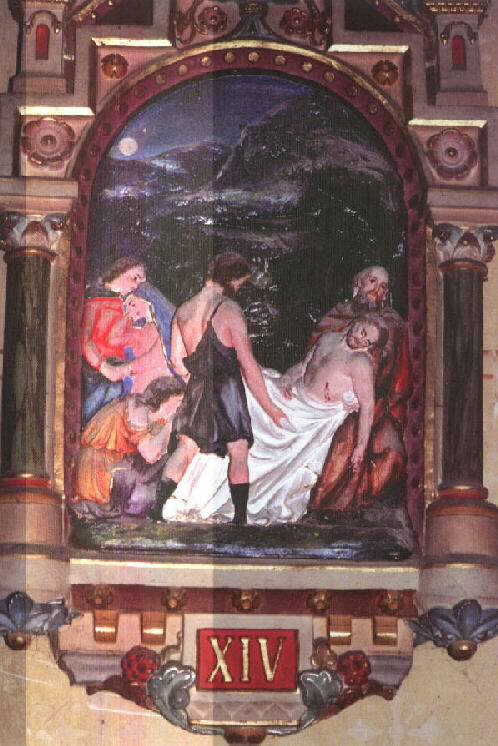 Mr. Smith as well as others who defend the 'faith' refuse to look at the
evidence that was first revealed in Holy Blood Holy Grail.
Mr. Smith as well as others who defend the 'faith' refuse to look at the
evidence that was first revealed in Holy Blood Holy Grail.
And consider this from the new book The Jesus Papers by Michael Baigent; At
Rennes-le-Château there are paintings on the wall. They are called 'stations
of the cross'. They number from 1 to 14. The final painting commissioned
by Sauniere reveals this; The moon is shown as having risen, night has
fallen, the Passover has begun. No one of the Jewish faith would be
handling a dead body at this time. This image is depicting Jesus,
still living, being carried out of his tomb rather than into it.
We discuss this further and the overwhelming evidence we had 4 years
before this book came out on
The real Resurrection
This simply means the 'Jesus Papers' Baigent has seen with his own eyes
are not fake and someone has translated them. Even if they didn't, the gospels
actually reveal the truth.
For those who wish to explore the occult (secret) teachings we found this site. It does explain many of the symbols used by the Templars and their reverence to John... tracyrtwyman from his site; It is not by the magical strength of HERCULES that one deciphers these mysterious symbols engraved by observers of the past.
This is a reference to the cave known as the Tomb of Hercules (a.k.a Enoch), which is covered with hieroglyphic symbols, just as the tomb of Hermes (a.k.a. Enoch) supposedly is.
In the sanctuary, nevertheless the font of benediction, fountain of love of the believers, reminds us of these words again: “BY THIS SIGN YOU WILL CONQUER.”
Dagobert II, to whom the treasure of Rennes-le-Chateau is said to belong, was also
murdered at midday, and “midday” is mentioned specifically in the parchments found by
Sauniere. As for the rest of this passage, I have been unable thus far to decipher it conclusively.
This “ruined house”, like the story of the ruined Temple of Solomon, or the ruined
Tower of Babel, represents the loss of the Grail wisdom after the Deluge.
If anyone saw the National Geographic special intitled "The Gospel Of Judas", the Forbidden Forward page will explain why Jesus was laughing at the disciples when they offered a prayer to their god. We are fairly sure the origional Templars knew about this. The Merovingian Kings were also aware of this secret.
Not only this, but other information found in the book The Woman with the Alabaster Jar by Margaret Starbird, and many other similar books that have been published on this subject that give solid evidence that the Christanity of today is not what was believed or practiced in 30 - 70 A.D. ( as we said, Jesus was NOT Christian nor did he start this Roman influenced cult.)
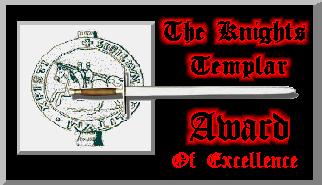 Stephen Dafoe is a Knights Templar Historian who lives in Canada. He was interviewed
by A & E for a TV documentary about the Knights Templar and one for vision TV. Mr Defoe
has also written two books; The Warriors and Bankers with Alan Butler and Unholy
Worship: The Myth of the Baphomet, Templar, Freemason Connection. He is also the
co-author of a book called the "Templar Continuum". Mr.Dafoe has kindly bestowed his
Templar Award of Excellence on this site, for which I am
eternally grateful. click on the award for his page.
Stephen Dafoe is a Knights Templar Historian who lives in Canada. He was interviewed
by A & E for a TV documentary about the Knights Templar and one for vision TV. Mr Defoe
has also written two books; The Warriors and Bankers with Alan Butler and Unholy
Worship: The Myth of the Baphomet, Templar, Freemason Connection. He is also the
co-author of a book called the "Templar Continuum". Mr.Dafoe has kindly bestowed his
Templar Award of Excellence on this site, for which I am
eternally grateful. click on the award for his page.
Knights Templar Research Ring.
|
||
|
This
Knights Templar Research Ring site |
|
The webmasters need help, see our personal page
Up dated; 01/27/09; Info on 'The Wars on Terror'. The plane crashes at The World Trade Center, the Pentagon, and flight 93 were all staged and carried out by the US. government. The Inside scoup see Attack on America
Continued on The Foundation of the Knights Templar
The Crusades continued on The Crusades and more
The Copper scroll and the treasure continued on The Copper Scroll and more The Catholics version of the story.
More Templar Links
Grand Priory of England and Whales
Templar Sites all over the world Information Resources on the Knights Templar
If you read the information on Forbidden about the cross, you know what the cross symbolizes. The first page of that series on Forbidden Forward reveals the secret that most Masons have known for centuries.
More surpressed information surfaces on The Marriage of Jesus and Mary
"And the Spirit came to him in haste when it raised him.
Having given its hand to the one lying prone on the ground, it placed him firmly on his feet, for he had not yet stood up.
He gave them the means of knowing the knowledge of the Father and the revelation of his son.
For when they saw it and listened to it, he permitted them to take a taste of and to smell and
to grasp the beloved son". Sound familiar?..
from The Gospel of Truth
in the Nag Hammidi scrolls.
These pages are a new series explaining the relationship of the Mason's to Egypt and Egyptian religion.
Our Main Page Hiram Abiff, King of Egypt, 1554 BC
Our page on King Solomon
The Great Builders, Including Solomon's Temple.
This site has a third page, which covers, Oklahoma sites including the Oklahoma Indian Degree Team, our Order of Eastern Star and other Oklahoma links. PAGE 3
This guest book is set to not allow postings to be displayed until reviewed. Not because of negative comments but because a bored young lady filled in 4 or more comment sections and thought it was cute. We don't delete negative comments unless they contain profanity or they contain comments that call Masons devil worshipers ect., which we catagorize as a religious debate and is unexceptable. If you care to read the forbidden forward page, you will see real secrets revealed.


View My Guestbook
 Sign My Guestbook
Sign My GuestbookNO PART OF THIS SITE MAY BE COPIED OR REPRODUCED, IN WHOLE OR IN PART WITHOUT THE EXPRESS WRITTEN APPROVAL OF THE WEBMASTER. © COPYRIGHT 1999 - 2010 C.I.Case...ALL RIGHTS RESERVED.
If your site is not Masonic in nature, We kindly ask that you do
not link to this site without permission of the Web Master under the guidelines set forth here...
Legal Issues
This site has been visited... Times since November 30th, 1999
"Great spirits have always encountered violent opposition from mediocre minds" -- Albert Einstein
"I may not agree with what you have to say, but I shall defend to the death your right to say it!" Quote from Sir Lancelot
